Restriction enzyme digestion:
Restriction enzymes recognize specific nucleotide sequences (recognition sequences) in double-stranded DNA that are generally four five or six nucleotides long and then cut both strands of the DNA at specific locations. There are typically three ways in that the DNA can be cut; a staggered cut to leave a 5' over- hang for instance a short single-stranded region of DNA is left which has a 5' end and overhangs the end of the double-stranded DNA, a staggered cut to leave a 3'overhang, or a cut in the similar place on both strands to leave a blunt end. For enzymes which cut in the staggered manner, the single-stranded tails are known as cohesive ends because they permit any two DNA fragments produced through the same restriction enzyme to form complementary base couples. The cut ends can

Figure: The three types of cleavage by commonly used restriction enzymes.
then be joined together (ligated) through an enzyme known as DNA ligase. The new DNA molecule which has been made through joining the DNA fragments is known as a recombinant DNA molecule. Blunt-ended DNA molecules can also be connected together through DNA ligase but the reaction is less favorable.

Figure: Using a restriction enzyme to create recombinant DNA.